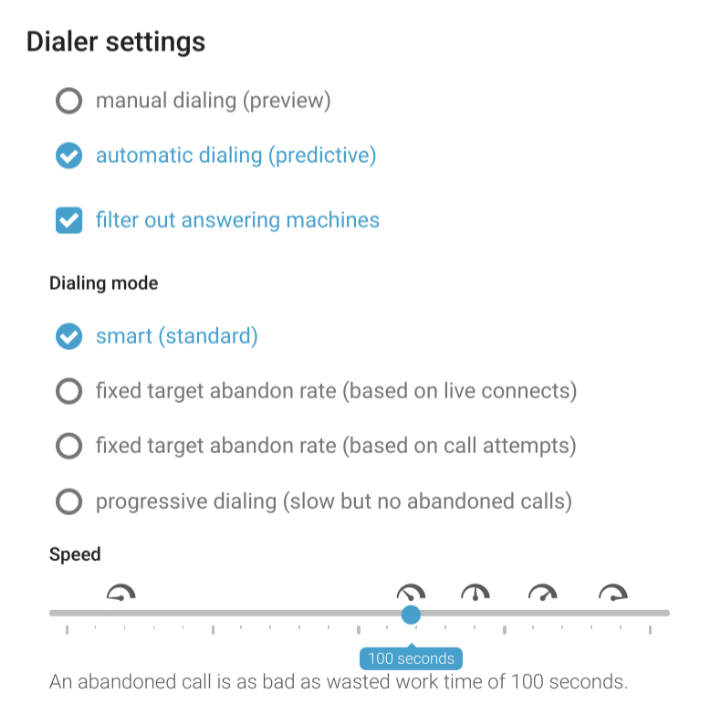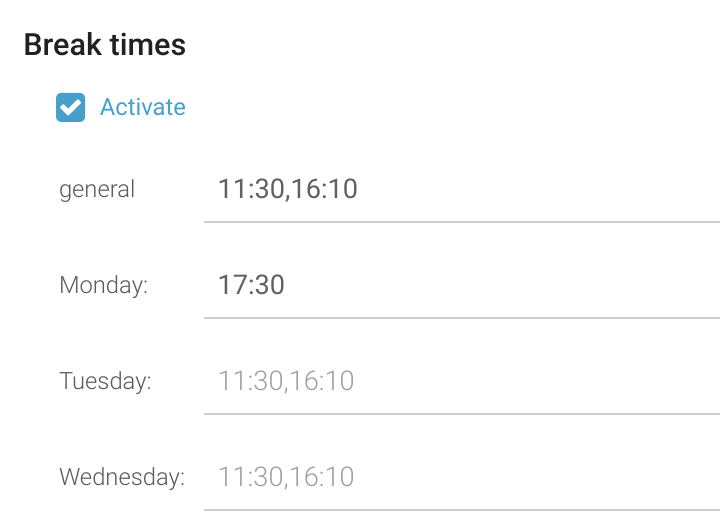Dialer on the leash
Compliance with dialing regulations is now very easy. Dialfire will do exactly as you say.

Dialfire is known for its particularly powerful predictive dialer, the standard dialing algorithm is based on the idea of both minimizing waiting times and disturbance of customers.
However, some markets have regulations for predictive dialing in place that focus on other metrics. Previously, manual readjustment of the dialer was required to maintain the appropriate parameters. This is now changing, allowing Dialfire to reach its full potential even in highly regulated markets.
Dialing modes

If you now look at the dialer settings in a call campaign task, then four different dialing modes are showing behind automatic dialing, which we will introduce to you in the following.
Smart mode (standard)
Smart mode is and will remain the standard mode. Its function is unchanged, but you can now not only set it in 5 steps, but virtually steplessly via the slider. But what exactly do you set with this slider? Questions keep coming up.
Predictive dialing means that an algorithm predicts both the available agents and the customer's availability, so it dials the next customer as early as possible to reduce the agent's waiting time when the agent is ready for a new call.
It can happen that a customer is reached but no agent is actually ready to take the call. The dialer then hangs up the customer connection and this is called an abandoned call. Without this risk, predictive dialing is not possible.
The ringing time at the customer's premises is also dynamically determined by the dialer and is between 15 and 40 seconds, which sometimes means that the dialer cancels the dialing before the customer has had a chance to answer the call. As this is also a nuisance to the customer, Dialfire evaluates this possibility in smart mode similar to an abandoned call.
Predictive dialing is always a trade-off between wasted agent time and the disturbance of the customer through abandoned calls, so you set the slider to how much agent call time you are willing to sacrifice to avoid another abandoned call.
Dialfire then ensures the best possible compromise based on this specification, regardless of the number of agents or availability in the contact list.
We recommend choosing this mode if you do not have to comply with any deviating regulatory requirements, as this mode best balances your profitability and customer satisfaction over a longer period of time.
Fixed target abandon rate based on live connections
This mode specifies that only a certain fixed percentage of live customer connections may become an abandoned call, the percentage being determined by local legislation.
The dialer tries to keep the set rate for this call level at all times. However, it needs some time to learn the exact behavior of the agents and the connect rate of the contact list. For this reason, the rate can be exceeded at the beginning of the campaign and should be within the set range after 5000 calls at the latest.
We recommend this mode for calls to the United States, the United Kingdom, Canada, Australia and New Zealand, and all other countries where the abandon rate of live connections is regulated.
Always keep an eye on the abandoned call rate via the dialer statistics yourself, as incorrect operation of the system can in some cases lead to the specification being exceeded.
Fixed target abandon rate based on dial attempts
In this mode, the allowed rate of abandoned calls is defined in relation to the dialing attempts, and here too it can take up to 5000 dialing attempts before the rate is met.
We recommend this mode for the German market, as the code of honour for the call center industry defines the rate on the basis of the dialing attempts.
If you use this mode, then you should not set the maximum number of dial attempts per contact too low, since failed dial attempts have a positive effect on the rate and thus ultimately on the waiting time of the agents.
Progressive dialing
In this mode no predictive dialing takes place, but only as many customers are dialed as there are agents waiting for a connection, thus avoiding abandoned calls.
Progressive dialing is much slower than predictive dialing, but still much faster than manual dialing. As a setting option, you can configure the length of the ringing time at the contact's site. Note, that if set too low, the waiting time for the agent will be shorter, but it will also decrease the reachability, because some customers will still have been on the way to their phone. We recommend setting it to about 20 seconds.
You should only use this mode if your client or the law explicitly prohibits predictive dialing.
Sources of error
Avoiding abandoned calls only works as well as the dialer's predictions, but there are a few little tricks you can use to help the dialer avoid unnecessary abandoned calls and ultimately save a lot of waiting time.
Sudden end of shift
Many call centers have strict working time rules with fixed shift ends and break times. And although the dialer expects that not every agent will immediately move on to the next call, it is still too much to foresee, if all agents suddenly finish work together.
In the module Settings > Dialer you can now define the times when your call center's shift ends or a common break begins, and Dialfire will then limit dialing to the agents who are actually waiting for a call within a 5 minute time range around these times.

This setting must always be made in the Dialfire account that is calling on a given campaign, as the working time regulations can be different for each call centre. Therefore if you outsource a campaign call task to another call center, ensure that they specify these times in their own account.
Aborting the dialing process
Another new feature is the possibility for an agent to interrupt the current predictive dialing process. This is still better than closing the browser completely, because the dialer can at least stop further dialing. However, for customers who are already being called, it may be too late. Additional abandoned calls must be expected.
Agents should therefore only use the abort option in exceptional cases.
Misleading address origin
The dialer evaluates the connect rate differentiated by the address source, which is located in the $source field. Therefore it is best to ensure that all contacts with the same value in the $source field actually come from exactly the same list source.
If you leave the file name of the import file there for each import (this is the default value) and the file name is always different, then this condition is already met.
If, on the other hand, you repeatedly import addresses from the exact same source, it is advantageous to fill this field with the same source name during the import, so that the dialer can fall back on the reachabilities of previous imports.
Answering machine recognition
All auto dialing modes support answering machine detection, which is based on the fact that people and answering machines normally answer the phone differently, but there remains a uncertainty that sometimes causes answering machines to be put through to the agent after all, or live connections to be incorrectly classified as answering machines and hung up.
Since the message on the telephone often barely differs from that of an answering machine for business customers, you should always switch off answering machine detection for B2B projects.
Please also observe any legal regulations that penalize such recognition errors and, in case of doubt, turn off this function.